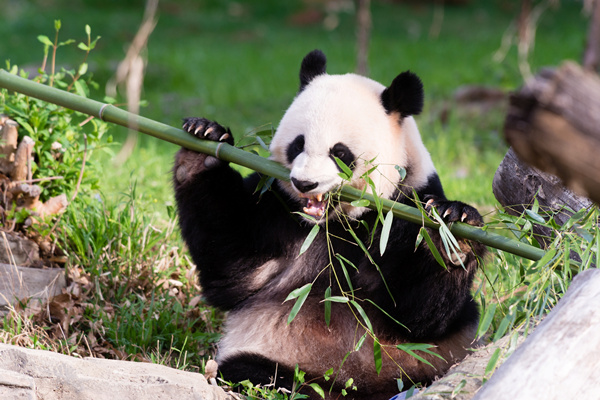 |
|
Giant panda Mei Xiang in a file photo taken on April 19, 2015. Photo courtesy of Smithsonian National Zoo |
The giant panda Mei Xiang at the National Zoo in Washington may be pregnant again.
Scientists at the Smithsonian Conservation Biology Institute have confirmed a secondary rise in Mei Xiang's urinary progesterone levels. The slow rise started July 20 and indicates that she will either have a cub or experience the end of a pseudopregnancy within 30 to 50 days, the zoo announced on Monday.
Scientists have been carefully tracking Mei Xiang's hormone levels since she was artificially inseminated on April 26 and 27, using frozen sperm collected from Hui Hui, a giant panda living in China, and fresh sperm collected from Tian Tian at the National Zoo.
"Our panda team has been monitoring Mei Xiang very closely since the procedures. Vets will continue regular ultrasounds as Mei Xiang chooses to participate in them," the zoo said in the announcement.
The team is monitoring changes in Mei Xiang's reproductive tract and evaluating for evidence of a fetus. The only way to definitively determine if a giant panda is pregnant is to detect a fetus on an ultrasound. Scientists will also continue to monitor her hormone levels through daily analyses, according to the zoo.
A female panda's behavior and hormones mimic a pregnancy even if she is experiencing a pseudopregnancy. Giant panda fetuses do not start developing until the final weeks of gestation, making it difficult to determine if there is a pregnancy. It may still be too early to detect a fetus on an ultrasound.
Mei Xiang is nest-building, choosing to spend more time in her den, and sleeping more and eating less, according to the zoo.
The area of the David M. Rubenstein Family Giant Panda Habitat closest to her den will soon close to provide her with quiet. Mei Xiang shows extra sensitivity to noise during the final weeks of a pseudopregnancy or pregnancy.
But the zoo said visitors to the giant panda habitat can see Tian Tian and Bao Bao outside as usual, as well as Mei Xiang, when she chooses to go into her outdoor exhibit.
Mei Xiang, born on July 22, 1998, has given birth to two surviving cubs, Tai Shan and Bao Bao. Tai Shan was born July 9, 2005, and he now lives in China. Bao Bao was born Aug 23, 2013. She will live at the zoo until she turns 4; she will then go to live in China and eventually enter the giant panda breeding program. Both Tai Shan and Bao Bao were born through artificial insemination.
Besides Washington, three US zoos — in San Diego, Atlanta and Memphis — keep giant pandas on loan from China.
Chinese and American scientists study giant pandas and conduct regular exchanges. Last month, Smithsonian Conservation Biology Institute Chief Veterinarian Copper Aitken-Palmer and veterinarians from the San Diego Zoo, Hong Kong Zoo and zoos from the Chinese mainland held a veterinary workshop at the Dujiangyan Panda Base to diagnose and elevate the level of medicine provided to giant pandas in China.
There were 394 captive pandas in China at the end of January, and another estimated 1,864 of them live in the wild, mostly in China's Sichuan, Shaanxi and Gansu provinces.